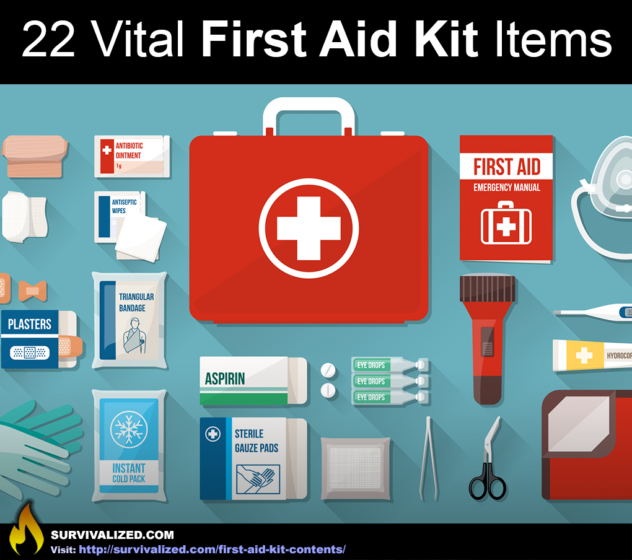
Having the right first aid kit contents can literally be the difference between life and death in a true emergency situation! When a catastrophic situation occurs, medical services often become overwhelmed and it becomes your responsibility at that point to fill the gap.
If a member of your family or a neighbor is seriously injured, his/her survival could easily come down to the quality of your first aid kit contents.
First Aid Kit Contents
- Assorted Adhesive Bandages - Found in most first aid kits, these little guys are great for small cuts and scrapes.
- Large Bandages - You’ll want to be prepared for larger injuries as well.
- Butterfly closure strips - These are used to close wounds without the use of sutures.
- Elastic Bandage - Wrapping a sprained ankle or wrist reduces its range of motion and protects it from further injury. Sprains are common, especially in chaotic situations, and can happen easily to those who are out of shape.
- Gauze Pads - An assortment of gauze pads in different shapes and sizes will come in handy.
- Medical Tape - You’ll need to tape to keep your gauze pads and some bandages in place. Get both the kind that has adhesive and the kind that does not but stretches and sticks to itself.
- Lighter - A Lighter can be used to sterilize metal tools in a pinch.
- Flashlight - You could easily get caught in a low light situation when you need to administer care. If an injury is serious ample lighting is critical!
- Bottle of Water - You may not have access to water for cleaning wounds or sanitizing your hands otherwise.
- Multipurpose Splint - Although many things can be used as a splint, it is good to have a multipurpose splint on hand for quick use. [They can be hard to find so here is a link to one]
- Antiseptic - Critical for reducing the possibility of infection and fighting bacteria.
- Soap - A universal way of cleaning minor wounds. Also good for sanitizing hands before treating injuries.
- Surgical Mask - Provides a layer of protection from airborne microorganisms.
- CPR Mask - A CPR Mask is simply used as a barrier between the person being revived and the person performing the CPR to prevent the transmission of viruses.
- Thermometer - Digital thermometers tend to be quicker but require a battery. It is probably good to have a fluid based thermometer (the kind which uses the red dye) as a backup just in case.
- Tweezers and a Magnifying Glass - Splinters are not only painful and annoying but can get infected easily. And for those of us with less than great vision, a magnifying glass is a must in this type of situation.
- Eye Wash Kit - When you need to flush debris out of your eyes, a good eye wash kit (including eye cup) is a big deal.
- Instant Cold Pack - These provide a great way of reducing swelling, especially when there is no access to ice.
- Latex Gloves - When aiding those that may be infected with a virus or harmful bacteria, these gloves will provide a necessary protective barrier.
- Pain Reliever - Including a variety of pain relievers such as Tylenol, Ibuprofen, and aspirin is important.
- Glucosameter - This is an essential device (which measures blood sugar levels) for those who suffer from diabetes or hypoglycemia.
- Blood Pressure Cuff - One of the primary tools used in assessing a person's condition in a trauma situation.
Having the right first aid kit contents can make a critical difference in being prepared. It’s just as important to know how and when to use the contents you are less familiar with, so make sure you put in enough study to be prepared to treat common serious injuries. There are quite a few good courses, instructional videos, and websites that can prepare you.
